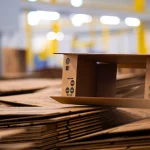Green case studies: Portuguese initiatives benefitting communities and building sustainable futures
At the latest RedBridge Community event in Lisbon on June 20, Julian Johnson, founder and partner of Tejo Ventures and founder of the Little Lions project, and Jorge van Krieken, founder of Green Heritage, told inspiring stories in a conversation with Raquel Sampaio, co-founder and CEO of Direito Mental/Executive VP of Mind Alliance.
Text: Chris Graeme; Photo: Carlos Cirilo
Julian Johnson of Tejo Ventures was born and brought up in Kenya before moving to South Africa with the early part of his career in London. Julian has been an entrepreneur his whole life and admits he was a “very scrappy entrepreneur” as he didn’t know how to raise money.
He started out by saving money from working in a post office, then started an agency and a software business which he sold, and went on to become an angel investor, travelling around the world for a few years having fun and investing money in ideas and people.
Julian arrived in Portugal in 2016. “I was very excited about the development environment and had never built anything before”. He admits that he had undiagnosed ADHD at the time and didn’t realise that that was “the kind of thing people (with the disorder) do.”
“I thought cool! Lisbon is half built and I should try and help rebuild it”. Julian says he had incredible luck and opportunities with the people he met and immediately set to work on some projects that are still ongoing in Lisbon.
Ecologically responsible investments
Just over three years ago, Julian got more seriously interested in the investing space and started a Golden Visa investment fund to invest in venture and clients. He has set up one fund already deployed half in Portugal and half in the US.
“The first was a random venture. We invested in everything from AI to Space and including Climate, Education, Sustainability and Renewable Energy. Now Tejo Ventures is doing a renewables project in Portugal”, he says.
This shift towards sustainability and renewables, he says, was a kind of calling since he had been obsessing about climate for 20 years.
The climate crisis quite literally gave him insomnia. “I just felt within me that the climate catastrophe was really bad, and I had this very unnerving experience sharing what I thought was going on with clients and friends who were very well educated”.
Many said: “Oh, it’s nothing to worry about. It’s for our kids and grandkids to worry about” and that seemed to him like a really bad answer from what he had been reading and learning.
Because he was so engaged with his businesses he hadn’t really been able to actively engage with he climate crisis and build anything of impact being young and naive. “I became very outspoken, which I realised was ineffective because people thought I was boring and annoying”.
Julian then started tree-planting initiatives and signed up to becoming a climate leadership fellow attending the SEJ annual climate conference in Philadelphia.
“I came away terrified because the world’s best climate scientists on the stage confirmed all that I had been reading. They were all using the word ‘hope’ quite a lot, and it’s not a great word to use when talking about mankind surviving on the planet as a species”.
Niche green energy opportunities
Julian then decided to commit his own life to trying to be useful, and thought about finding the entrepreneurs who were trying to build solutions. “I started investing in alternative meat companies and carbon extraction companies, and over three years ago realised that the Golden Visa was a way to raise funding.
Tejo Ventures is now investing Golden Visa monies in niche green energy opportunities where it debt finances small energy projects like solar energy and storage projects on schools, warehouses, factories, and government buildings.
“The good thing is that energy transition is now fully happening and at pace, not just because of government policies, but because the market economics work. It’s the cheapest energy in the world; the fastest growing technology of all time,” he says.
Portugal, in fact, has one of the cheapest electricity supplies in the world, and Julian says it now makes sense to build one new infrastructure than the current one for energy generation.
“There’s a big paradigm change and a ton of money invested in big solar parks. Our model involves investing €300,000 or €500,00 putting solar panels on the roofs of factories and using solar batteries. It’s a debt facility that is collateralised, pays dividends to our investors, puts equity in the portfolio and then we sell it”.
Little Lions Project
One of the projects close to Julian’s heart is his Little Lions project in Nairobi, Kenya which aims to alleviate some of the hardships of the Kibera slum – one of the largest in Africa – through the power of education.
Rooted in the vibrant tapestry of the Cape Town townships and rapidly expanding throughout South Africa, Little Lions has become more than an organisation; it has become a movement.
“The project, which aims to build schools in the slum, addresses impact and sustainability. When you are really poor the last thing you’re worrying about is sustainability and saving planet Earth. We have to lift people out of poverty first,” he says.
Julian found out about a group of kids whose school had been closed down during Covid. “We fed about 150 kids for a few months, and realised we needed to educate them too and started the project”.
The slums are unimaginable from the perspective of our cosy Western European lifestyles. Built of corrugated iron, they have no services, electricity is usually stolen, and they are surrounded by piles of waste and open sewers. Water has to be collected in buckets from stand pipes put in by local NGOs.
The homes have no running water, no plumbing, and for every one toilet in blocks there are several thousand users who have to pay to use them. Energy comes from charcoal and kerosene stoves giving off toxic fumes.
There is no refrigeration either, so meat has to be hung and eaten as quickly as possible. People earn US$4 per day and buy single-use items. Clothing is second hand, everything is repaired, and education is delivered in a shack in which there are typically up to 200 kids in a classroom.
“Even in this slum there is an incredible amount of hope and even in the depths of suffering there is resilience, and in poverty there is dignity around community”, he says.
Julian points out that it is hard to build a school in a slum. The dynamics of getting thing done are mired in corruption. It’s all about muscle and influence, and there are no title deeds.
“You have to learn to engage in communities in a different way, and produce value through exchange, and we organise initiatives such as trash collection and free medical treatment.”
The Little Lions leased an old 1950s government building and renovated it, turning it into one of the three schools it runs today. Many of the children have been orphaned by AIDS. The school has a restaurant on the roof to feed the children properly twice daily and Little Lions is currently starting a bone broth kitchen to feed around 5,000 children.
The teaching programme uses the British curriculum, offers free internet, a book club, and has a playing field for football games.
“One of the things we teach the parents is not to beat their kids, explaining to them that traumatised kids grow up to be traumatised adults who are not so effective and productive as human beings and will likely will be poorer.”
Architecture in the blood
Jorge van Krieken is the founder of Green Heritage Eco-homes, a company of ecological bio-construction projects committed to creating a more sustainable future. It builds houses that are ecologically responsible, respect the environment, and create pleasant and healthy homes in which to live.
Portuguese and born in Mozambique, Jorge had worked as an investigative journalist reporting on the civil war and decided to retire at 46 and buy a house in central Portugal with views over onto the Serra da Estrela to spend his retirement with his wife and young children.
“One day my wife ordered me to build a new house and went to stay in the guest house on our farm. I was excited by the idea. My great-grandfather, Gerardus Samuel van Krieken (1864-1933), had come to Portugal in 1890 from Rotterdam. He had been educated in Geneva at the lyceum and at that time the Portuguese government invited school teachers and architects to teach decorative arts.”
Marrying a Portuguese girl, he went on to design the Basilica of Fátima (1925-1928) and several mansions around Portugal. (Palacete dos Viscondes de São João da Pesqueira, Porto and Faculty of Medicine, Porto)
Homes made of straw
His father too was a builder. “Half of my family were architects or builders, and the other half journalists. I had this opportunity to build a house and with some friends from Germany built that house in just eight hours and that’s where it all started,” he recalls.
We’ve all heard of the children’s tale ‘The Three Little Pigs’ where the big bad wolf blows the straw house down and eats the piglet. Well, that certainly wouldn’t be the case in some parts of the United States where tornadoes are common and houses built of straw are the best bet for survival.
Inspired, Jorge came up with the idea of straw-based construction from bales of hay. It had been used in Nebraska in the 19th century (a territory with few forests) to build the straw bale buildings, many of which date from the early 1900s and 1920s.
Bales, he says, are a great insulator against sound as well as temperature, and the weight of the roof sits directly on straw walls with no wood framing.
Post and beam homes with straw in-fill are more common in Nebraska than load bearing ones in modern straw bale construction (though both are found), but the original bale buildings used as little wood as possible. Just as in sod houses, no wood is needed to support the roof in bale buildings.
“Someone had the idea of picking up bales of hay and cladding them with clay to make houses during the 1970s after the OPEC crisis. It was a very well regulated way of building and there was excellent technical information available”, Jorge explains.
A few years later he started his own company transforming a ruin on hectares of land in the middle of Portugal for a German client.
The beauty of cork
The business developed with his French partner employing BIM (Building Information Modelling), using Eco-friendly materials such as clay, lime, stone, plaster, hemp, cork, wood, glass, ceramics and other essential elements like cement and steel.
As he explains, using cork in construction was pioneered by John T. Smith from New York in 1890 and patented in1892. There had been a fire in his warehouse, the roof had collapsed, and the firemen discovered that the bales of cork had not only survived but expanded like popcorn.
John Smith discovered that by using heat and pressure to release the naturally occurring resins, he could create a conglomerate of cork particles that didn’t need any binder. “It is the best insulation you can ever find.”
“We cover the whole house with cork. The production is done with the aid of CNC (Computer Numerical Control). It actually takes more time to do the stone walls than to make he rest of the house using cork walls,” says Jorge.
In the summer cork has an amazing ability to keep heat out and keep the interiors cool. With a typical heat of 40º outside the ambient indoor temperature is a pleasant 27º, therefore saving on power guzzling air conditioning units.
Other projects can be more complex such as a recent project done in Sintra which used natural products that do not contain any toxic formaldehydes.
“It’s about reducing CO2 and embracing the circular economy, and we often invite local companies and show them how to make more sustainable buildings. In Portugal, we currently need hundreds of thousands of new affordable houses providing a healthy environment”, he says.
Inspired by great architects
And architectural history has other examples of Eco-homes, some of which go back to the 1930s such as the Usonian houses designed by Frank Lloyd Wright (1867-1959) who inspired Joesph Eichler (1900-1974).
Between 1949 and 1966, Joseph Eichler’s company, Eichler Homes, built more than 11,000 homes in nine communities in Northern California and homes in three communities in Southern California.
Eichler homes are examples of Modernist architecture that has come to be known as “California Modern”, and typically feature glass walls, post-and-beam construction, and open floor-plans in a style indebted to Frank Lloyd Wright and Mies van der Rohe.
Eichler home exteriors featured flat and/or low-sloping A-framed roofs, vertical 2-inch pattern wood siding, and spartan facades with clean geometric lines. He industrialised the whole process and built affordable prefabricated houses for US$9-10,000 a that time.
One of Eichler’s signature concepts was to “bring the outside in”, achieved via skylights and floor-to-ceiling windows with glass transoms looking out on protected and private outdoor rooms, patios, atriums, gardens, and swimming pools.
And in Portugal, as far back as the 1750s timber-framed houses designed to be earthquake resistant were being built under the guidance of the Marquis de Pombal’s architects and engineers Manuel da Maia, Eugénio dos Santos, Elias Sebastião Pope and Carlos Mardel.
This technique that required little carpentry was the forerunner to the widely used Cross Laminated Timber Technique (CLT) which is manufactured in panels that have an odd number of softwood plank layers laid on top of each other at right angles and glued together under pressure. The panels come in widths of up to 3m, lengths of up to 16m and are typically 50-300mm thick. Walls, floors and roofs can be made out of pre-fabricated panels, reducing construction time and delivering whole-life cost savings.
“We need to be able to build homes in Portugal in weeks rather than years and this can be done through technology and materials like these,” Jorge says.
There is also a movement to build Eco-villages, and perhaps some of these ideas that stretch back to the 1950s could be the answer to solving Portugal’s chronic housing shortage.










